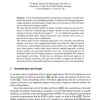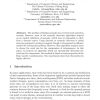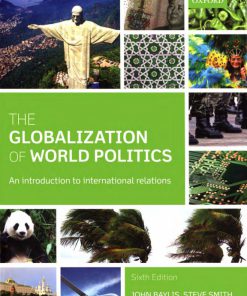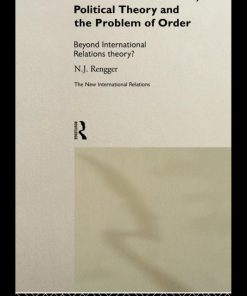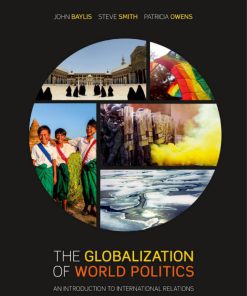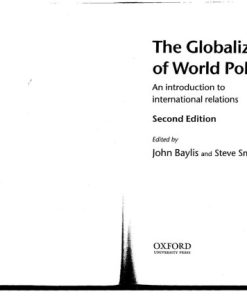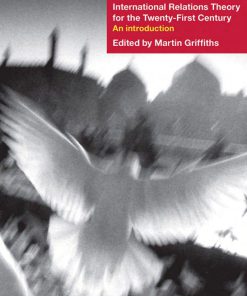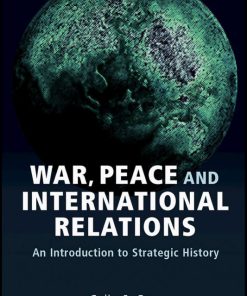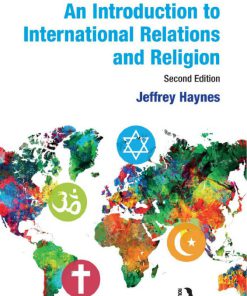The Global Politics of Power Justice and Death An Introduction to International Relations 1st Edition by Peter Anderson 0415109450 9780415109451
$50.00 Original price was: $50.00.$25.00Current price is: $25.00.
Authors:Peter J.Anderson , Series:International Relation [31] , Tags:Education; Politics & IR; Sociology & Social Policy , Author sort:J.Anderson, Peter , Languages:Languages:eng , Published:Published:Sep 2005 , Publisher:Routledge , Comments:Comments:Education, Politics & IR, Sociology & Social Policy
The Global Politics of Power Justice and Death An Introduction to International Relations 1st Edition by Peter Anderson – Ebook PDF Instant Download/Delivery. 0415109450, 9780415109451
Full download The Global Politics of Power Justice and Death An Introduction to International Relations 1st Edition after payment

Product details:
ISBN 10: 0415109450
ISBN 13: 9780415109451
Author: Peter Anderson
This exciting new text adopts a challenging question-led approach to the major issues facing global society today, in order to investigate the nature and complexity of global change. Among other things it looks at the future of the state, the environment, the international political economy, war and global rivalries, and the role of international law and the UN in the post-Cold War world. The book devises a readily comprehensible “change map”, which both incorporates a wide range of the fundamental concepts of international relations theory and suggests a number of new concepts capable of assisting the investigation of global change. This new framework is deployed to look closely at real world issues in order to isolate the crucial factors which determine whether or not mass hunger, for example, or enviromental abuse, can be eliminated.
The Global Politics of Power Justice and Death An Introduction to International Relations 1st Table of contents:
Chapter 1: A Game Beyond Chess: Explaining the Global Change Map
Introduction
Competition In Global Politics
The Competing Attitudes and Perceptions of Political Elites, Administrative Elites, Business, Technical and Cultural Elites and the Wider Population With Regard to the Desirability of Specific Goals That May Affect Global Change—The Battle for Dominance
The Role of Ideology, Imperatives and Interests
The Role of Power and Influence
The Role of Fortune
The Role of Opportunity Factors
Using the Map
Chapter 2: The American Pivot
What Factors Can Influence US Policy On Global Change?
How Important Is All of This for Global Change?
Chapter 3: Can the State Survive? The Threat from Economic Global Interfusion
Introduction
Preliminary Questions
The Threat to the State Posed By the Global Liberal Capitalist Economic System: The View of Traditional Liberals
The Views of Interventionist Liberals
The Views of the Less Developed States
The Plight of the Former Soviet Union
The Threat from Increasing Global Economic Interfusion — Multinationals Under the Microscope
The Threat to States from International Finance
The Final Balance—For and Against the Liberal System
Chapter 4: The Second Challenge: The Threats to the State from Scientific, Technological and Cultural Aspects of Global Interfusion
Introduction
The Effects of Pollution Internationally
The Effects of Scientific and Technological Developments
Cultural Factors and the Age of Global Travel
The Collective Implications of These Factors for the State
Conclusions
Chapter 5: Global Environmental Problems
Introduction
What Are the Major Current Threats to the Global Environment?
What Are the Solutions to Global Environmental Problems?
What Are the Obstacles In the Way of Solutions?
How and to What Extent Might Such Obstacles Be Overcome?
Chapter 6: The Political Economy of Death: What Causes Global Poverty?
Introduction
Absolute Poverty and Development
What Are the Main Causes of the Global Poverty Problem?
Chapter 7: An End to Global Poverty?
What Are the Solutions to the Global Poverty Problem?
What Are the Obstacles In the Way of the Solutions?
How and to What Extent Might the Obstacles to Solutions Be Overcome?
Women and Development
Chapter 8: A Second United States? Integration In Western Europe
Introduction
What Is the EU and How Far Has Integration Really Gone Within It?
What Are the Main Incentives Towards Further Integration?
What Are the Main Obstacles In the Way of Further Integration?
Chapter 9: The Future of European Integration
Introduction
To What Extent Are the Incentives Towards Further Integration Likely to Overcome the Obstacles?
Scenario I: An Examination of the Possibility of the Emergence of an EU Common Defence Policy
Scenario II: The Single Market and the EMU
Would Continuing European Integration Be a Benefit or a Cost to the Global Community?
Concluding Comments
Chapter 10: Global Rivalries and the Causes of War
Introduction
What Are the Causes of War? An Introduction
A Selective Journey Through Ideas On the Causes of War
Chapter 11: The Control of War
Introduction
To What Extent Can War Be Eliminated?
Are There Some Methods of War Prevention Which Are More Successful Than Others?
Chapter 12: The Problem of ‘Murderous’ and ‘Aggressive’ Regimes— The Role of International Law and the United Nations
Introduction
How Has International Law Developed As a Means of Controlling the Actions of Governments?
What Changes Did the United Nations System Bring?
How Has International Law Attempted to Ensure the Effective Protection of Human Rights?
To What Extent Does International Law Allow the Use of Military Force to Protect Human Rights?
What Action Can Regional Bodies Undertake?
Conclusion
Conclusion: The Future— Can It Be Anticipated and Changed?
Anticipating the Future
Interaction and Global Change
Linkages Between Issues
Conclusion
Appendix: The Wider Purposes of the Change Map
Glossary
Notes
1. A Game Beyond Chess: Explaining the Global Change Map
2. The American Pivot
3. Can the State Survive? The Threat from Economic Global Interfusion
4. The Second Challenge: The Threats to the State from Scientific, Technological and Cultural Aspects of Global Interfusion
5. Global Environmental Problems
6. The Political Economy of Death: What Causes Global Poverty?
7. An End to Global Poverty?
8. A Second United States? Integration In Western Europe
9. The Future of European Integration
10. Global Rivalries and the Causes of War
11. The Control of War
12. The Problem of ‘Murderous’ and ‘Aggressive’ Regimes —The Role of International Law and the United Nations
Conclusion: The Future—Can It Be Anticipated and Changed?
Select Bibliography
People also search for The Global Politics of Power Justice and Death An Introduction to International Relations 1st:
violence as a means of asserting power
violence is the purest expression of power
violence and power
violence in global politics

